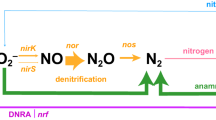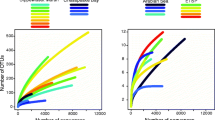Abstract
Denitrification in the ocean is a major sink for fixed nitrogen in the global N budget, but the process is geographically restricted to a few oceanic regions, including three oceanic oxygen minimum zones (OMZ) and hemipelagic sediments worldwide. Here, we describe the diversity and community composition of microbes responsible for denitrification in the OMZ using polymerase chain reaction, sequence and fragment analysis of clone libraries of the signature genes (nirK and nirS) that encode the enzyme nitrite reductase, responsible for key denitrification transformation steps. We show that denitrifying assemblages vary in space and time and exhibit striking changes in diversity associated with the progression of denitrification from initial anoxia through nitrate depletion. The initial denitrifying assemblage is highly diverse, but succession on the scale of 3–12 days leads to a much less diverse assemblage and dominance by one or a few phylotypes. This progression occurs in the natural environment as well as in enclosed incubations. The emergence of dominants from a vast reservoir of rare types has implications for the maintenance of diversity of the microbial population and suggests that a small number of microbial dominants may be responsible for the greatest rates of transformations involving nitrous oxide and global fixed nitrogen loss. Denitrifying blooms, driven by a few types responding to episodic environmental changes and distributed unevenly in time and space, are consistent with the sampling effect model of diversity–function relationships. Canonical denitrification thus appears to have important parallels with both primary production and nitrogen fixation, which are typically dominated by regionally and temporally restricted blooms that account for a disproportionate share of these processes worldwide.







Similar content being viewed by others
References
Aarssen LW (1997) High productivity in grassland ecosystems: affected by species diversity or productive species? Oikos 80:183–184
Bange HW, Andreae MO, Lal S, Law CS, Naqvi SWA, Patra PK, Rixen T, Upstill-Goddard RC (2001) Nitrous oxide emissions from the Arabian Sea: a synthesis. Atmos Chem Phys 1:61–71
Bange HW, Naqvi SWA, Codispoti LA (2005) The nitrogen cycle in the Arabian Sea. Progress in Oceanography 65:145–158
Braker G, Zhou JZ, Wu LY, Devol AH, Tiedje JM (2000) Nitrite reductase genes (nirK and nirS) as functional markers to investigate diversity of denitrifying bacteria in Pacific northwest marine sediment communities. Applied and Environmental Microbiology 66:2096–2104
Brettar I, Rheinheimer G (1992) Influence of carbon availability on denitrification in the Central Baltic Sea. Limnol Oceanogr 37:1146–1163
Capone DG, Burns JA, Montoya JP, Subramaniam A, Mahaffey C, Gunderson T, Michaels AF, Carpenter EJ (2005) Nitrogen fixation by Trichodesmium spp.: an important source of new nitrogen to the tropical and subtropical North Atlantic Ocean. Glob Biogeochem Cycles 19:GB2024
Carpenter JH (1965) The Chesapeake Bay Institute Technique for the Winkler dissolved oxygen method. Limnology and Oceanography 10:141–143
Codispoti L, Brandes J, Christensen J, Devol A, Naqvi S, Paerl H, Yoshinari T (2001) The oceanic fixed nitrogen and nitrous oxide budgets: moving targets as we enter the anthropocene? Sci Mar 65:85–105
Codispoti LA, Yoshinari T, Devol AH (2005) Suboxic respiration in the oceanic water columm. In: del Giorgio PA, Williams PJL (eds) Respiration in aquatic ecosystems. Oxford University Press, Oxford, pp 225–247
Deutsch C, Sarmiento JL, Sigman DM, Gruber N, Dunne JP (2007) Spatial coupling of nitrogen inputs and losses in the ocean. Nature 445:163–167
Devol AH (1978) Bacterial oxygen uptake kinetics as related to biological processes in oxygen deficient zones of the oceans. Deep-Sea Res 25:137–146
Devol AH, Uhlenhopp AG, Naqvi SWA, Brandes JA, Jayakumar DA, Naik H, Gaurin S, Codispoti LA, Yoshinari T (2006) Denitrification rates and excess nitrogen gas concentrations in the Arabian Sea oxygen deficient zone. Deep-Sea Res 53:1533–1547
Ferguson RL, Buckley EN, Palumbo AV (1984) Response of marine bacterioplankton to differential filtration and confinement. Appl Environ Microbiol 47:49–55
Garfield PD, Packard TT, Friederich GE, Codispoti LA (1983) A subsurface particle maximum layer and enhanced microbial activity in the secondary nitrite maximum of the northeastern tropical Pacific Ocean. J Mar Res 41:747–768
Goering JJ (1968) Denitrification in oxygen minimum layer of eastern tropical Pacific Ocean. Deep-Sea Res 15:157–164
Grasshof K, Ehrhardt M, Kremling K (1983) Methods of seawater analysis, Vol. Verlag Chemie GmbH, Weinheim
Heck KL, Belle Bv, Simberloff D (1975) Explicit calculation of thee rarefaction diversity measurement and the determination of sufficient sample size. Ecology 56:1459–1461
Holland SM (2001) Analytic Rarefaction 1.3, Vol. University of Georgia, Athens, GA
Hughes JB, Hellmann JJ, Ricketts TH, Bohannan BJM (2001) Counting the uncountable: Statistical approaches to estimating microbial diversity. Applied and Environmental Microbiology 67:4399–4406
Huston MA (1997) Hidden treatments in ecological experiments: re-evaluating the ecosystem function of biodiversity. Oecologia 110:449–460
Jayakumar DA, Francis CA, Naqvi SWA, Ward BB (2004) Diversity of nitrite reductase genes (nirS) in the denitrifying water column of the coastal Arabian Sea. Aquat Microb Ecol 34:69–78
Jayakumar A, Naqvi, S.W.A and Ward B.B. Distribution and Relative Quantification of key Genes Involved in Fixed Nitrogen Loss From the Arabian Sea Oxygen Minimum Zone. (in press, AGU monograph—‘Indian Ocean Biogeochemical Processes and Ecological Variability’)
Korner H, Zumft WG (1989) Expression of denitrification enzymes in response to the dissolved-oxygen level and respiratory substrate in continuous culture of Pseudomonas stutzeri. Appl Environ Microbiol 55:1670–1676
Kuypers MMM, Lavik G, Woebken D, Schmid M, Fuchs BM, Amann R, Jorgensen BB, Jetten MSM (2005) Massive nitrogen loss from the Benguela upwelling system through anaerobic ammonium oxidation. Proceedings of the National Academy of the United States of America 102:6478–6483
Lam P, Jensen MM, Lavik G, McGinnis DF, Muller B, Schubert CJ, Amann R, Thamdrup B, Kuypers MMM (2007) Linking crenarchaeal and bacterial nitrification to anammox in the Black Sea. Proceedings Of The National Academy Of Sciences Of The United States Of America 104:7104–7109
Loreau M, Naeem S, Inchausti P, Bengtsson J, Grime JP, Hector A, Hooper DU, Huston MA, Raffaelli D, Schmid B, Tilman D, Wardle DA (2001) Biodiversity and ecosystem functioning: current knowledge and future challenges. Science 294:804–808
McCune G, Grace JB (2002) Analysis of ecological communities, Vol. MjM Software Design, Gleneden Beach, OR, USA
Morris RM, Rappe MS, Connon SA, Vergin KL, Siebold WA, Carlson CA, Giovannoni SJ (2002) SAR11 clade dominates ocean surface bacterioplankton communities. Nature 420:806–810
Morrison JM, Codispoti LA, Smith SL, Wishner K, Flagg C, Gardner WD, Gaurin S, Naqvi SWA, Manghnani V, Prosperie L, Gundersen JS (1999) The oxygen minimum zone in the Arabian Sea during 1995. Deep-Sea Res II-Top Stud Oceanogr 46:1903–1931
Naqvi SWA, Jayakumar DA, Narvekar PV, Naik H, Sarma V, D’Souza W, Joseph S, George MD (2000) Increased marine production of N2O due to intensifying anoxia on the Indian continental shelf. Nature 408:346–349
Naqvi SWA, Naik H, Narvekar PV (2003) The Arabian Sea. In: Black K, Shimmield G (eds) Biogeochemistry of marine systems. Blackwell, Oxford, pp 156–206
Naqvi SWA, Kumar MD, Narvekar PV, De Sousa SN, George MD, D’Silva C (1993) An intermediate nepheloid layer associated with high microbial metabolic rates and denitrification in the northwest Indian Ocean. J Geophys Res 98:16469–16479
Naqvi SWA, Shailaja MS (1993) Activity of the respiratory electron-transport system and respiration rates within the oxygen minimum layer of the Arabian Sea. Deep-Sea Res II-Top Stud Oceanogr 40:687–695
Naqvi SWA, Yoshinari T, Jayakumar DA, Altabet MA, Narvekar PV, Devol AH, Brandes JA, Codispoti LA (1998) Budgetary and biogeochemical implications of N2O isotope signatures in the Arabian Sea. Nature 391:462–464
Nicholls JC, Davies IM, Trimmer M (2007) High-resolution profiles and nitrogen isotope tracing reveal a dominant source of nitrous oxide and multiple pathways of nitrogen gas formation in the central Arabian Sea. Limnol Oceanogr 52:156–168
Pak H, Codispoti LA, Zaneveld JRV (1980) On the intermediate particle maximum associated with the oxygen-poor waters off western South America. Deep-Sea Res 27:783–797
Porter KG, Feig YS (1980) The use of DAPI for identifying and counting aquatic microflora. Limnol Oceanogr 25:943–948
Santoro AE, Boehm AB, Francis CA (2006) Denitrifier community composition along a nitrate and salinity gradient in a coastal aquifer. Appl Environ Microbiol 72:2102–2109
Scala DJ, Kerkhof LJ (1999) Diversity of nitrous oxide reductase (nosZ) genes in continental shelf sediments. Applied and Environmental Microbiology 65:11681–11687
Schloss PD, Handlesman J (2005) Introducing DOTUR, a computer program for defining operational taxonomic units and estimating species richness. Appl Environ Microbiol 71:1501–1506
Schmid M, Walsh KA, Webb R, Rijpstra WIC, van de Pas-Schoonen K, Verbreuggen ML, Hill TCJ, Moffett BF, Fuerst J, Schouten S (2003) Candidatus “Scalindua broad”, sp. nov., Candidatus “Scalindua wagneri”, sp. nov., two new species of anaerobic ammonia oxidizing bacteria. Syst Appl Microbiol 26:529–538
Schwartz MW, Brigham CA, Hoeksema JG, Lyons KG, Mills MH, van Mantgem PJ (2000) Linking biodiversity to ecosystem functeion: implications for conservation ecology. Oecologia 122:297–305
Spinrad RW, Glover HE, Ward BB, Codispoti LA, Kullenberg G (1989) Suspended particle and bacterial maxima in Peruvian coastal waters during a cold water anomaly. Deep-Sea Res 36:715–733
Strous M, Heijnen JJ, Kuenen JG, Jetten MSM (1998) The sequencing batch reactor as a poweful tool for the study of slowly growing anaerobic ammonium-oxidizing microorganisms. Appl Environ Microbiol 50:589–596
Strous M, Pelletier E, Mangenot S, Rattei T, Lehner A, Taylor MW, Horn M, Daims H, Bartol-Mavel D, Wincker P, Barbe V, Fonknechten N, Vallenet D, Segurens B, Schenowitz-Truong C, Medigue C, Collingro A, Snel B, Dutilh BE, Op den Camp HJM, van der Drift C, Cirpus I, van de Pas-Schoonen KT, Harhangi HR, van Niftrik L, Schmid M, Keltjens J, van de Vossenberg J, Kartal B, Meier H, Frishman D, Huynen MA, Mewes HW, Weissenbach J, Jetten MSM, Wagner M, Le Paslier D (2006) Deciphering the evolution and metabolism of an anammox bacterium from a community genome. Nature 440:790–794
Thamdrup B, Dalsgaard T, Jensen MM, Ulloa O, Farias L, Escribano R (2006) Anaerobic ammonium oxidation in the oxygen-deficient waters off northern Chile. Limnol Oceanogr 51:2145–2156
Thompson JD, Gibson RJ, Plewniak F, Jeanmougin F, Higgins DG (1997) The CLUSTAL X Windows interface: flexible strategies for multiple sequence alignment aided by quality analysis tools. Nucleic Acids Research 25:4876–4882
Tilman D, Lehman CL (2002) Biodiversity, composition, and ecosystem processes: theory and concepts. In: Kinzig AP, Pacala SW, Tilman D (eds) The functional consequences of biodiversity, empirical progress and theoretical extensions. Princeton University Press, Princeton, NJ, USA
Tilman D, Lehman CL, Thompson KT (1997) Plant diversity and ecosystem productivity: theoretical considerations. Proc Natl Acad Sci USA 94:1857–1861
Ward BB, Tuit CB, Jayakumar A, Rich JJ, Moffett J, Naqvi SWA (2008) Organic carbon, and not copper, controls denitrification in oxygen minimum zones of the ocean. Deep-Sea Res. I, 55:1672–11683
Acknowledgments
This work was supported by US National Science Foundation grants to BBW and AJ. We thank Hema Naik and P. V. Narvekar for the nutrient analyses and Caroline B. Tuit for assistance with the bag incubations.
Author information
Authors and Affiliations
Corresponding author
Rights and permissions
About this article
Cite this article
Jayakumar, A., O’Mullan, G.D., Naqvi, S.W.A. et al. Denitrifying Bacterial Community Composition Changes Associated with Stages of Denitrification in Oxygen Minimum Zones. Microb Ecol 58, 350–362 (2009). https://doi.org/10.1007/s00248-009-9487-y
Received:
Accepted:
Published:
Issue Date:
DOI: https://doi.org/10.1007/s00248-009-9487-y




